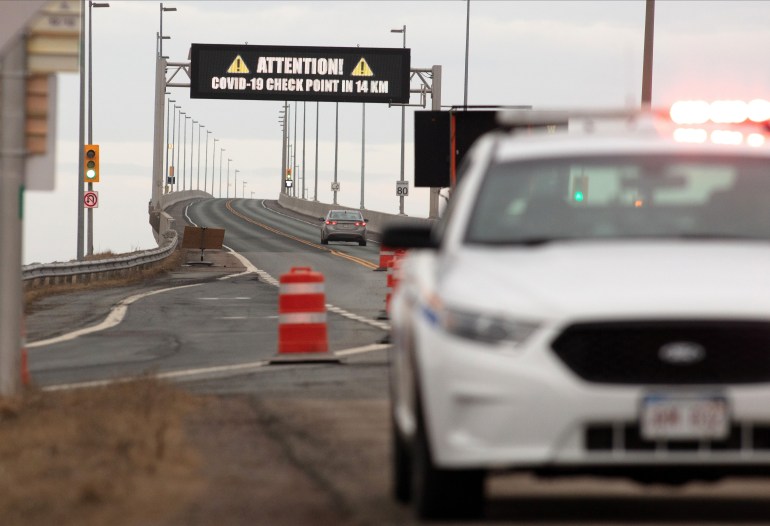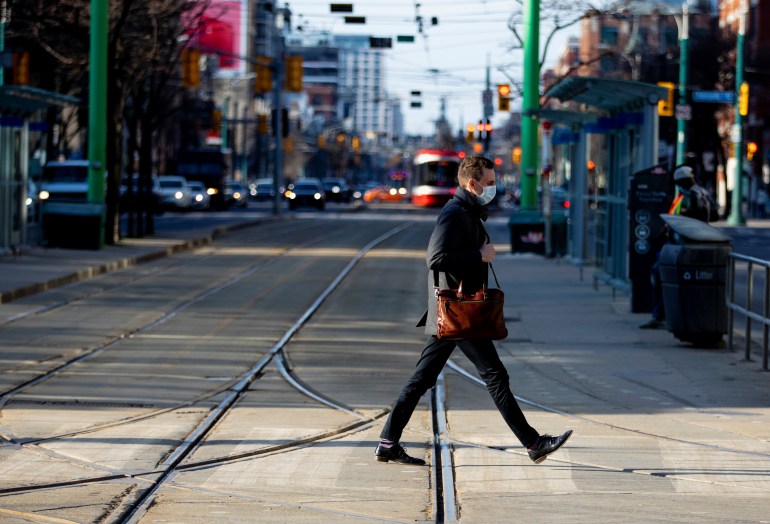As COVID rages in Canada, Atlantic provinces set model to follow
Experts say strong leadership and quick, decisive action in Atlantic Canada helped region stem spread of the virus.

Halifax, Canada – As Canada grapples with a devastating third wave of COVID-19, the country’s eastern region stands as an oasis of normalcy, with case numbers dwindling and many of the most onerous restrictions now lifted.
While the four Atlantic provinces have only around 200 active cases combined, the national hotspot of Ontario has surpassed 30,000, with new infections being detected daily in record numbers. The provinces of Alberta and Quebec are also in the throes of a severe third wave, each with more than 10,000 active cases, and British Columbia follows close behind.
Keep reading
list of 4 items‘Tragic combination’: Millions go hungry amid Brazil COVID crisis
India hits new record high of nearly 169,000 daily COVID cases
England takes major step out of COVID lockdown; PM urges caution
Beyond the sparsely populated territories of northern Canada, where COVID-19 has been all but eliminated, the Atlantic provinces of Nova Scotia, New Brunswick, Prince Edward Island, and Newfoundland and Labrador are being hailed as a unique success story.
“The Atlantic provinces all had strong communication, collaboration [and] cooperation between public health authorities, which is almost entirely absent elsewhere in Canada. That allowed them to coordinate their strategies,” Colin Furness, an infection control epidemiologist at the University of Toronto, told Al Jazeera.
Strict limitations on travel from outside the region helped to minimise new cases, and by keeping the case count low, “they were able to really pounce on new cases with contact tracing, testing and isolation,” he added.

Remote, smaller population
Beyond case numbers, infection rates show a stark difference between eastern Canada and the rest of the country: As of Monday, the rate of total cases of COVID-19 since the pandemic began in Nova Scotia was 181 per 100,000 population, compared with 2,654 per 100,000 population in Ontario.
From the outset, Atlantic Canada’s relative remoteness and small population, as compared with dense urban centres such as Toronto and Montreal, helped it avoid a more severe outbreak. The eastern region, home to about 2.4 million people, is not a global travel hub, making COVID-19 easier to control.
But differing policy approaches by provincial and territorial governments, which are responsible for their respective healthcare networks, have also played a role.
While the lockdowns accompanying the first wave of COVID-19 last spring were relatively similar across Canada, “the post-lockdown period has been marked by a panoply of dissimilar policy approaches,” notes a study published last month by the University of Oxford.
Those responses ranged from Alberta’s “pro-business” approach to the highly regulated “Atlantic bubble” in eastern Canada, which allowed residents to travel between the four provinces but imposed a mandatory 14-day quarantine for visitors from outside the region. This served as “a big deterrent for non-essential travel”, said Emily Cameron-Blake, a research assistant with Oxford’s COVID-19 Government Response Tracker and the lead on subnational Canadian data collection.

In Nova Scotia, people who have failed to self-isolate after entering the province, or who contravened other public health guidelines, have faced hefty fines, with the provincial Justice Department noting that more than 900 tickets have been issued for various offences.
As tourism dried up and airlines cancelled routes to the region, the strict quarantine regime also raised concerns about the high economic costs – but regional governments made it clear that the priority was curbing the spread of the virus and ensuring hospitals would not get overwhelmed.
In parts of Atlantic Canada, the restrictions have periodically been tightened into outright bans on non-essential travel from other provinces, with exceptions made for things like work, medical appointments and compassionate reasons. In Newfoundland and Labrador, the Canadian Civil Liberties Association challenged such a ban, arguing that provinces cannot exclude other Canadians from entry – but the province’s Supreme Court upheld the restrictions.
Other regions of Canada have avoided such severe steps, but from a public-health perspective, it has been to their detriment, experts say.
“BC, Alberta, Saskatchewan, Ontario and Quebec have not had interprovincial travel restrictions that required travellers from other provinces to self-isolate upon arrival. They have had ‘advisories’ and ‘recommendations’ against non-essential travel, but without enforcing an isolation, most people have been able to move fairly freely into and out of these provinces,” Cameron-Blake told Al Jazeera.

Effective communication
The Oxford study also found important differences in the “public face” of the pandemic from one province to the next. While provinces such as PEI have relied on health officers to convey key updates and information, others have put premiers and ministers in the spotlight.
In Ontario, which has faced repeated rounds of lockdowns and reopenings, the “cumbersome command structure … was not led by public health expertise”, the study notes. Premier Doug Ford’s approach has been widely criticised as arbitrary and confusing; a five-tiered, colour-coded system of restrictions – with cities repeatedly moving in and out of severe lockdowns – has fuelled uncertainty and frustration.
“Overall, the provinces used really vague language when it came to what was and was not permitted. This was likely intentional, but also likely confusing to residents in understanding what is and is not permitted,” Cameron-Blake said. “Without clearly defined policies and restrictions, humans have a tendency to push the limits.”
Lisa Barrett, an infectious disease specialist at Dalhousie University in Nova Scotia, said Atlantic Canada’s success has been due in part to the guiding principle that “prudence is best” when it comes to COVID-19 restrictions.

“Early and definitive action has been important … [and] because of consistent messaging, because we’ve had good leadership from various people both in government and in the community, people have been very engaged. They’ve felt that they were a part of the pandemic response, and therefore, they’ve been very, very adherent to the restrictions that have been in place,” Barrett told Al Jazeera.
This contrasts with the approaches in other provinces, such as Ontario and Quebec, where “people opened things up before there were good, quantitative, number-based reasons to do so … and when ‘lockdowns’ were put into place, they were partial”, Barrett said. “Essential activity included things that were not essential, like buying duvet covers.”
COVID zero
In recent weeks, variants of concern, including the more transmissible B117, have also surged in provinces such as Ontario and Alberta. While such variants have been detected in the Atlantic region among people who travelled outside of the four provinces, they do not appear to have gained a foothold, as stringent quarantine measures continue to be enforced upon arrival.
Against this backdrop, thousands of Canadians are signing on to a petition calling for a “zero COVID strategy” across the country. Citing “tremendous urgency” as cases surge, the petition urges the federal and provincial governments to take immediate action to eliminate the spread of COVID-19 countrywide, “just as the Atlantic provinces and the Territories have successfully done”.
Countries such as New Zealand, Australia, Vietnam, Laos and Taiwan have also adopted “zero COVID” strategies by implementing exceptionally stringent quarantine and lockdown rules to effectively halt transmission of the virus.
A key part of the fight to eliminate COVID-19 is to provide support and vaccinations to essential workers and people who do not have the financial or social capacity to stay isolated, Barrett said. The Atlantic model of a 14-day quarantine for interprovincial travellers should be replicated elsewhere, she said, noting it is still possible for other provinces to turn the tide.
“Don’t roll things back too fast, keep your lockdowns in place, get vaccine where it’s needed, and do a heck of a lot more testing and engaging people properly,” Barrett said. “I think that actually would make a difference.”
